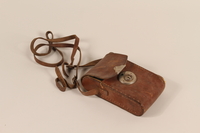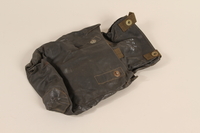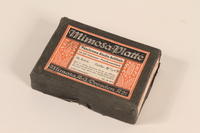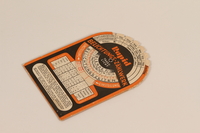Overview
- Brief Narrative
- Goerz Coat Pocket Tenax camera and photographic accessories used by Sergeant Walter E. Hunkler, medical technician, 160th Field Artillery Battalion, 45th Infantry Division, known as the Thunderbirds, from June 1943 to September 1945. In July 1943, Walter entered combat in Sicily and then advanced with his unit through Italy, France, and Germany. Walter’s unit was with the 157th Infantry when, on April 29, they arrived with the 45th Infantry at and liberated Dachau concentration camp in Germany. There were nearly 30,000 starving and dying prisoners in need of aid. Walter photographed the camp and prisoners with one of the two cameras that he carried. Walter’s Dachau photographs are part of this collection, 2000.526.1. Walter was awarded a Bronze Star for bravery while tending the wounded.
- Date
-
use:
approximately 1943
manufacture: 1912-1925
- Geography
-
manufacture:
Berlin (Germany)
- Credit Line
- United States Holocaust Memorial Museum Collection, Gift of Roberta E. Hunkler
- Markings
- a. lens ring, engraved : DOGMAR 1:4,5 F = 10 cm. 578534 D.R.P. C.P. GOERZ BERLIN [Deutsches Reichspatent]
a. front, below lens, engraved : TENAX / C. P. GOERZ BERLIN / D.R.P. Nr. 206814. [Deutsches Reichspatent]
a. front, top center, engraved : M B Z
a. front left side, engraved : gesp.
a. front, right side, top wheel, aperture settings, engraved : 4,5 6,3 9 12,5 18 25 36
a. front, right side, bottom wheel, engraved : 1 2 5 10 25 50 100 250
a. top, left end, dial, engraved : Meter 1,5 inf, 10 7 6 5 4 3 2
a. top, right end, plastic circle, embossed : FERDNA?SO? ?GSREN? / Centralsfelle / ~fur~ / Photographie / Mü? St?2
a. ground glass back, bottom, engraved, white paint : 262573
a. interior, front panel, left end, engraved : 3531 262573
a. interior, front panel, right end, engraved : No 746248
b. front, bracket plate, engraved : BREV. SGDG. / FOREIGN PATS.
b. interior, flap hasp, engraved : TUCK-TITE / U.S.A. PAT. 1590400 / GES. GESCH / MADE IN GERMANY [Gesetzlich Geschutzt legally patented]
c. front, blue ink : Die erste Pflicht- / Dein Augenlichtl / Optiker Spaethe / Darmstadt, Ernst Ludwigstr. 22 [The first duty - your eyesight Spaethe Optometrist Darmstadt, Ernst Ludwig Street. 22]
d. top, embossed : Cg
e. top, center, embossed : (g?)auff / D.R.P. / ang [Deutsches Reichspatent]
f. lid, top center, embossed logo : LIFA
f. base, bottom center, embossed : Made in Germany / Importe de’l Allmange
f. inner lid, top and underside, center, embossed : LIFA
f. lens ring, top, engraved : LIFA / Panchrom 0/32
g. lid, paper label, black ink : Ø 31 mm / Nr. 307/1 / G 1 - Contributor
-
Subject:
Walter E. Hunkler
Manufacturer: C. P. Goerz
Distributor: Optiker Spaethe
Manufacturer: LIFA-Lichtfilterfabrik
- Biography
-
Walter Eugene Hunkler was born on February 8, 1915, in Washington, Illinois. He was the second of two children born to John and Bertha Geiger Hunkler. His parents were born in Switzerland and immigrated to the United States. John was a teamster and day laborer. Walter graduated from high school and became a bartender. He married and had a child, but later divorced.
After the December 7, 1941, Japanese attack on Pearl Harbor, Germany declared war on the US and a few days later America entered World War II. On January 19, 1942, Walter was drafted into the US Army. Walter became a medical technician, assigned to a medical detachment, 160th Field Artillery Battalion, 45th Infantry Division, nicknamed the Thunderbird Division. In June 1943, the Division was deployed to Europe. Walter went into combat that July in Sicily, Italy. As the Division advanced through Italy and France, Walter participated in several campaigns: Anzio, Rome-Arno, Southern France, and Ardennes-Alsace-Battle of the Bulge. In spring 1945, the Division advanced into Germany. Walter’s unit was operating with the 157th Infantry when, on April 29, 1945, the 45th Infantry liberated Dachau concentration camp in Germany. They discovered over 30,000 survivors in the camp and 2,310 corpses on a train. Walter witnessed and photographed atrocities, the horrible camp conditions, and the surviving inmates. Following Germany’s May 7 surrender, the 45th Infantry was stationed near Dachau. Walter returned to the US in September 1945, and was honorably discharged as a Technician Fourth Grade in October. He was deployed overseas for 691 Days; 511 of them in combat. He received a Bronze Star for bravery for risking his own safety while tending to the wounded, as well as many battle stars for campaigns where his unit fought.
Walter returned to Washington, Illinois, and worked for the Central Illinois Light Company. In October 1956, Walter married Roberta Leighton (1916 – 2007). Walter did not speak about his wartime experiences. Only once, in 1947, did he allow Roberta to see the photographs he took at Dachau before sealing them inside a storage container where they remained for over fifty years. Walter, 76, died on September 8, 1991, in Peoria, Illinois.
Physical Details
- Classification
-
Audiovisual and Photographic Materials
- Category
-
Cameras
- Object Type
-
Tenax camera (lcsh)
- Physical Description
- a. Sheet film strut camera in a rectangular black leatherette covered metal casing with rounded ends with an open back and an open front with an inset, flat black painted metal panel with 2 release buttons on the top and bottom edges. Upon release, the panel and the attached rectangular black leather bellows extend forward on 4 sliding metal struts, which scissor open along panel edge slots. On the front panel is a clear glass lens in a black painted metal ring; on the right edge is a rectangular, clear glass sighting lens with red crosshairs in a hinged, black painted frame that folds into the panel. Above and below the lens are 2 flush engraved setting wheels. On the top left is an engraved arrow with a lever with a shutter lever below it. At the top is a sliding indicator in a kidney shaped slot, a small, circular clear glass sighting lens in a hinged metal holder that folds flat, and a flat metal focusing wheel. On the bottom is a threaded tripod mount. On the rear over a velvet bordered opening is a removable focusing back with a black painted metal frame for a flat piece of ground glass covered by a folding leatherette viewing hood.
b. Stiff, rectangular, textured dark brown leather camera case with a curved front, rounded ends, and a straight back. The elongated oval sides are lined with cardboard and attached with offwhite thread. It has a flap top with a U-shaped, silver colored metal hasp for a lockplate on the front. The exterior is decorated with 2 parallel lines. A short strap with a buckle is inserted through 2 cut out loops and wraps around the case. The interior is lined with worn, red-brown cloth. It was manufactured between 1926 and 1945.
c. Well used, rectangular yellow lens cleaning cloth with pinked edges. Eyeglasses and German text are printed on the front in blue ink.
d. Rectangular, black leatherette covered metal pack film holder with a left hinged top and a flat, black painted base frame. There is a metal release at the right end: on the bottom is a sliding horizontal bar with a center post and vertical end hooks which catch on perpendicular tabs at each end of a thin plate nailed to the top. Pushing the center post slides the hooks and releases the top. The interior base has a large, rectangular opening covered by a thin, flat removable panel with an extension tab on the right. The long bottom edges extend into narrow runners to mount it to a camera (a).
e. Rectangular, black painted, thin metal sheet film holder with a short lipped removable lid with 2 notches at 1 end. The lid interior has black velvet glued to the top end. The open base frame has a top hinge above a red velvet strip. On the Inside are bent metal strips on each side and a black velvet strip on top. There is a black paper wrapped cardboard insert, 2. x 3.625, in the base.
f. Circular, shiny black plastic LIFA box base and telescoping lid with a raised rim. Inside is a circular white plastic cap, 1.625 x 0.250, with a raised rim. Beneath the cap is a circular flat green glass filter, 1.250 x 0.250, mounted in a black painted metal ring with 3 evenly spaced bottom tabs.
g. Circular, red paper covered cardboard box base and telescoping lid with a paper label glued to the top. A brown corrugated cardboard circle rests in the base. Inside is a circular flat yellow glass filter, 1.250 x 0.250, mounted in a flat topped silver colored metal ring with 2 engraved 5-point stars. A black painted metal band with 4 evenly spaced cut tabs is held to the ring bottom by 3 tabs. - Dimensions
- a: Height: 4.125 inches (10.478 cm) | Width: 5.750 inches (14.605 cm) | Depth: 1.625 inches (4.128 cm)
b: Height: 6.000 inches (15.24 cm) | Width: 5.125 inches (13.018 cm) | Depth: 2.125 inches (5.398 cm)
c: Height: 2.750 inches (6.985 cm) | Width: 4.000 inches (10.16 cm)
d: Height: 3.250 inches (8.255 cm) | Width: 5.250 inches (13.335 cm) | Depth: 0.625 inches (1.588 cm)
e: Height: 4.125 inches (10.478 cm) | Width: 2.750 inches (6.985 cm) | Depth: 0.500 inches (1.27 cm)
f: Depth: 0.500 inches (1.27 cm) | Diameter: 1.875 inches (4.763 cm)
g: Depth: 0.625 inches (1.588 cm) | Diameter: 1.625 inches (4.128 cm) - Materials
- a : metal, leather, glass, paint, cloth
b : leather, cloth, cardboard, metal, thread
c : cloth, ink
d : metal, leather, paint
e : metal, paint, cardboard, paper, cloth, adhesive tape
f : plastic, glass, metal
g : cardboard, glass, metal, paper, ink, adhesive
Rights & Restrictions
- Conditions on Access
- No restrictions on access
- Conditions on Use
- No restrictions on use
Keywords & Subjects
Administrative Notes
- Legal Status
- Permanent Collection
- Provenance
- The camera and accessories were donated to the United States Holocaust Memorial Museum in 2000 by Roberta E. Hunkler, on behalf of the Estate of her husband, Walter E. Hunkler.
- Funding Note
- The cataloging of this artifact has been supported by a grant from the Conference on Jewish Material Claims Against Germany.
- Record last modified:
- 2023-08-25 16:40:44
- This page:
- https://collections.ushmm.org/search/catalog/irn513194
Download & Licensing
In-Person Research
- By Appointment
- Request 21 Days in Advance of Visit
- Plan a Research Visit
- Request to See This Object
Contact Us
Also in Walter E. Hunkler collection
The collection consists of two cameras, camera accessories, a cloth pouch, documents, and photographs relating to the experiences of Walter E. Hunkler, medical technician, 160th Field Artillery Battalion, 45th Infantry Division, United States Army in combat in Europe during World War II, including the liberation of Dachau concentration camp in Germany.
Date: 1942-1945 August

Six-20 Kodak camera and accessories used by US soldier
Object
Kodak Six-20 camera with art deco styling used by Sergeant Walter E. Hunkler, medical technician, 160th Field Artillery Battalion, 45th Infantry Division, known as the Thunderbirds from June 1943 to September 1945. This folding bellows camera was a portable model that took eight large 2 ¼ x 3 ¼ inch shots on a single no. 620 film roll. In July 1943, Walter entered combat in Sicily and then advanced with his unit through Italy, France, and Germany. Walter’s unit was with the 157th Infantry when, on April 29, they arrived with the 45th Infantry at and liberated Dachau concentration camp in Germany. There were nearly 30,000 starving and dying prisoners in need of aid. Walter photographed the camp and prisoners with one of the two cameras that he carried. Walter’s Dachau photographs are part of this collection, 2000.526.1. Walter was awarded a Bronze Star for bravery while tending the wounded.

Wehrmacht waterproof gas cape pouch found by US soldier
Object
German gas cape pouch found by Sergeant Walter E. Hunkler, medical technician, 160th Field Artillery Battalion, 45th Infantry Division, known as the Thunderbirds, from June 1943 to September 1945. The pouch was worn on a German soldier’s chest, attached to gas mask pouch shoulder strap. Walter may have used it to hold binoculars. In July 1943, Walter entered combat in Sicily and then advanced with his unit through Italy, France, and Germany. Walter’s unit was with the 157th Infantry when, on April 29, they arrived with the 45th Infantry at and liberated Dachau concentration camp in Germany. There were nearly 30,000 starving and dying prisoners in need of aid. Walter photographed the camp and prisoners with one of the two cameras that he carried. Walter’s Dachau photographs are part of this collection, 2000.526.1. Walter was awarded a Bronze Star for bravery while tending the wounded.

Mimosa 6.5 x 9 cm sheet film box used by US soldier
Object
Mimosa sheet film box used by Sergeant Walter E. Hunkler, medical technician, 160th Field Artillery Battalion, 45th Infantry Division, known as the Thunderbirds, from June 1943 to September 1945. The box held 6.5 x 9 cm film sheets which would fit the Tenax camera that he used during the war.In July 1943, Walter entered combat in Sicily and then advanced with his unit through Italy, France, and Germany. Walter’s unit was with the 157th Infantry when, on April 29, they arrived with the 45th Infantry at and liberated Dachau concentration camp in Germany. There were nearly 30,000 starving and dying prisoners in need of aid. Walter photographed the camp and prisoners with one of the two cameras that he carried. Walter’s Dachau photographs are part of this collection, 2000.526.1. Walter was awarded a Bronze Star for bravery while tending the wounded.

Photographic light exposure calculator used by US soldier
Object
Cardboard photographic light meter used by Sergeant Walter E. Hunkler, medical technician, 160th Field Artillery Battalion, 45th Infantry Division, known as the Thunderbirds, from June 1943 to September 1945.In July 1943, Walter entered combat in Sicily and then advanced with his unit through Italy, France, and Germany. Walter’s unit was with the 157th Infantry when, on April 29, they arrived with the 45th Infantry at and liberated Dachau concentration camp in Germany. There were nearly 30,000 starving and dying prisoners in need of aid. Walter photographed the camp and prisoners with one of the two cameras that he carried. Walter’s Dachau photographs are part of this collection, 2000.526.1. Walter was awarded a Bronze Star for bravery while tending the wounded.
Walter Hunkler papers
Document
Contains two documents titled allowing U.S. military officer to possess and/or mail "captured enemy military equipment," retrieved and used by Sergeant Walter Hunkler, dated August 20, 1945. One envelope with "Dachau" written on front and "44." Group of black and white photographs from Dachau, taken by Sergeant Hunkler, and othes gathered in Germany after liberation of the camp. The documents belonged to Walter Hunkler (donor's husband), Sergeant, assigned to medical detachment of the 160th Field Artillery Battalion, a unit of the 45th armored division that entered concentration camp Dachau in Germany on April 29, 1945.



